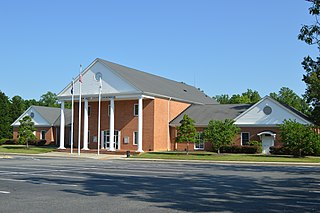
New Kent County is a county in the eastern part the Commonwealth of Virginia. As of the 2020 United States Census, its population was 22,945. Its county seat is New Kent.
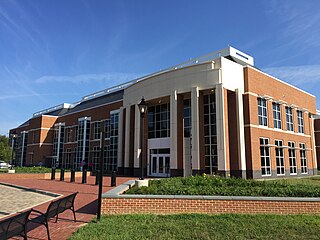
Hanover County is a county in the Commonwealth of Virginia. As of the 2020 census, the population was 109,979. Its county seat is Hanover Courthouse.

Hanover is a borough in York County, Pennsylvania, United States, 19 miles (31 km) southwest of York and 54 miles (87 km) north-northwest of Baltimore, Maryland and is 5 miles (8.0 km) north of the Mason-Dixon line. The town is situated in a productive agricultural region. The population was 16,429 at the 2020 census. The borough is served by the 717 area code and the ZIP Codes of 17331–34. Hanover is named after the German city of Hannover.
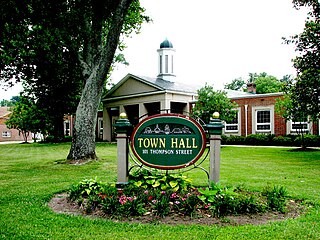
Ashland is a town in Hanover County, Virginia, United States, located 16 miles (26 km) north of Richmond along Interstate 95 and U.S. Route 1. As of the 2020 census it had a population of 7,565, up from 7,225 at the 2010 census.

The House of Hanover, whose members are known as Hanoverians, is a European royal house of German origin that ruled Hanover, Great Britain, and Ireland at various times during the 17th to 20th centuries. The house originated in 1635 as a cadet branch of the House of Brunswick-Lüneburg, growing in prestige until Hanover became an Electorate in 1692. George I became the first Hanoverian monarch of Great Britain and Ireland in 1714. At Queen Victoria's death in 1901, the throne of the United Kingdom passed to her eldest son Edward VII, a member of the House of Saxe-Coburg and Gotha. The last reigning members of the House of Hanover lost the Duchy of Brunswick in 1918 when Germany became a republic.

The Battle of Hanover took place on June 30, 1863, in Hanover in southwestern York County, Pennsylvania, as part of the Gettysburg Campaign of the American Civil War.

Williams Carter Wickham was a Virginia lawyer and politician. A plantation owner who served in both houses of the Virginia General Assembly, Wickham also became a delegate to the Virginia Secession Convention of 1861, where he voted against secession, but after fellow delegates and voters approved secession, he joined the Confederate States Army and rose to the rank of cavalry general, then became a Confederate States Congressman near the end of the American Civil War. Later, Wickham became a Republican and helped rebuild Virginia's infrastructure after gaining control of the heavily damaged Virginia Central Railroad, which he repaired and helped merge into the Chesapeake and Ohio Railway company. Cooperating with financier Collis Huntington, Wickham developed coal resources and the Newport News Shipyard. He was also again elected to the Virginia Senate. His son Henry T. Wickham also became a lawyer and would work with his father and eventually twice become the speaker pro tempore of the Virginia Senate.

State Route 2, formerly State Route 50, is a primary state highway in the U.S. state of Virginia. The state highway runs 53.08 miles (85.42 km) from U.S. Route 1 and US 301 in Richmond north to US 1 Business, US 17 Business, and SR 3 Business in Fredericksburg. SR 2 connects Richmond and Fredericksburg via Bowling Green. The state highway runs concurrently with US 301 from Richmond to Bowling Green and with US 17 Business in the Fredericksburg area.
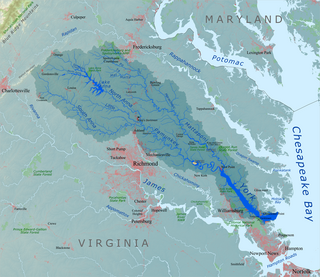
The Pamunkey River is a tributary of the York River, about 93 mi (150 km) long, in eastern Virginia in the United States. Via the York River it is part of the watershed of Chesapeake Bay.

State Route 30 is a primary state highway in the U.S. state of Virginia. The state highway runs 61.87 miles (99.57 km) from U.S. Route 1 in Doswell east to Interstate 64 (I-64) and SR 607 near Norge. SR 30 runs east–west through Hanover and Caroline Counties, connecting US 1 and I-95 with the Kings Dominion amusement park and US 301. The state highway serves as the principal highway of King William County, connecting U.S. Route 360 with SR 33 in West Point via the county's namesake county seat. SR 30 also connects SR 33 and US 60 in New Kent and James City Counties.

U.S. Route 301 is a part of the U.S. Highway System that runs from Sarasota, Florida, to Biddles Corner, Delaware. In Virginia, the U.S. Highway runs 142.70 miles (229.65 km) from the North Carolina state line near Skippers north to the Maryland state line at the Potomac River near Dahlgren. US 301 forms the local complement to Interstate 95 (I-95) from Emporia to Petersburg. The U.S. Highway runs concurrently with US 1 between Petersburg and the state capital of Richmond, where the highways form one of the main north–south avenues. US 301 continues north concurrent with Virginia State Route 2 to Bowling Green, forming an eastern alternative to I-95 and US 1 north of Richmond. At Bowling Green, which is connected to I-95 by SR 207, US 301 becomes the primary highway connecting Richmond and the Northern Neck with Southern Maryland. US 301 was constructed in four main segments: as the original SR 24 and then US 17-1 south of Petersburg, as US 1 from Petersburg to Richmond, as SR 2 from Richmond to Bowling Green, and as part of SR 207 toward Dahlgren. US 301 replaced US 17–1 in the early 1930s and was extended from Petersburg north along its current course into Maryland when the Potomac River Bridge was completed in 1940.

Hanover is an unincorporated community and census-designated place (CDP) in Hanover County, Virginia, United States. It is the county seat and is located at the junction of U.S. Route 301 and State Route 54 south of the Pamunkey River. While historically known as Hanover Courthouse, the U.S. Geological Survey, Census Bureau, Postal Service and residents refer to it as "Hanover". The population as of the 2010 census was 252.

State Route 54 is a primary state highway in the U.S. state of Virginia. Known for most of its length as Patrick Henry Road, the state highway runs 18.67 miles (30.05 km) from U.S. Route 33 in Montpelier east to US 301/SR 2 in Hanover Courthouse. SR 54 is the main east–west highway of Hanover County, connecting the western part of the county and the county seat with the central town of Ashland, where the highway meets US 1 and Interstate 95 (I-95).

State Route 271 is a primary state highway in the U.S. state of Virginia. Known as Pouncey Tract Road, the state highway runs 7.34 miles (11.81 km) from U.S. Route 250 in Short Pump north to SR 620 and SR 622 in Rockville. A small section of it was first added to the state highway system during 1930, and it gained its current routing and designation by 1940.
Pamunkey Regional Library serves the counties of Goochland, Hanover, King and Queen, and King William, and the towns of Ashland and West Point in central Virginia.
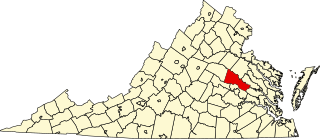
This is a list of the National Register of Historic Places listings in Hanover County, Virginia.
The Hanover Tomato is a mostly large variety of cultivated tomato grown in Hanover County, Virginia. While most Hanover Tomatoes that come to market are large fruits, they are not necessarily defined by their size but rather by the geographic setting—normally in coastal soil rich in sand—in which they are grown. The water retention in this type of soil is thought to influence the nature of the mature plant.
The Java Formation is a geologic formation in Kentucky, New York, Ohio, Pennsylvania, Tennessee, Virginia, West Virginia. It preserves fossils dating back to the Devonian period. The formation comprises the Pipe Creek Shale, Wiscoy Sandstone Member in New York, and Hanover Shale Member except in Tennessee.

The Harpers Formation is a geologic formation in Maryland, Pennsylvania, Virginia, and West Virginia, consisting of schist, phyllite, and shale. It dates back to the early Cambrian period. It is considered part of the Chilhowee Group.


















